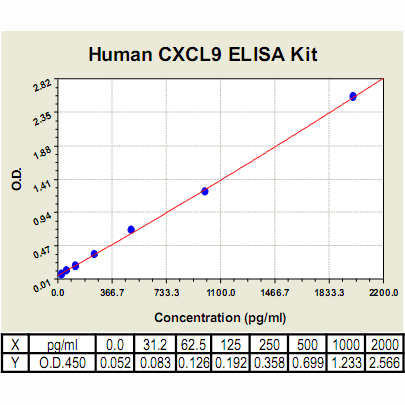Product Sheet CL0732
Description
BACKGROUND The chemoattractant cytokines (chemokines) are ubiquitous chemotactic molecules that play major roles in acute and chronic inflammatory conditions. They are divided into 4 families defined by the number of amino acids between the N-terminal cysteine residues (CC, CXC, CCX, and CX3C). The largest families are the CC and the CXC chemokines. The CXC chemokine family is a pleiotropic family of molecules that are involved in the trafficking of various leukocyte subsets, angiogenesis, and vascular remodeling.1 Although CXC chemokines with an N-terminal ELR (Glu-Leu-Arg) motif, such as IL-8, are specific chemoattractants for neutrophils, those lacking the N-terminal ELR motif, such as monokine induced by interferon- (IFN ) (CXCL9/Mig), CXCL10/IP-10, and IFN -inducible T-cell -chemoattractant (CXCL11/I-TAC), do not act as chemoattractants for neutrophils, but attract T helper (Th) 1 cells. These interferon-gamma inducible chemokines (CXCL9/Mig, CXCL10/IP-10, CXCL11/I-TAC) belong to the CXC sub-family. They represent an exception among chemokines in that they specifically interact with a single type of receptor, named CXCR3. These CXCR3-agonistic chemokines play an important role in inflammation through their T-cell chemotactic and adhesion-promoting activities. CXCL9 (MIG) and CXCL10 (IP-10) attract T cells and NK cells to the site of inflammation. These cells contain the receptor CXCR3 on their surface. Several studies have identified these molecules as key components of host responses in virus infections and in autoimmune diseases. For example, MHV infections of the CNS have identified a critical role for CXCL10 and CXCR3 in attracting T cells into the CNS and thus provide protection to the host.2 CXCL9 is highly expressed in skin lichen planus compared with other chemokines, such as CCL2, CCL20, and CXCL8. These examples provide evidence that the chemokines, CXCL9 and CXCL10, attract T cells to the site of infection and may provide in some cases, optimal defense against microbial pathogens. Alternatively, these processes may also provide the appropriate environment for autoimmune reactivity. In a murine model system they showed that the localized expression of CXCL9, incited an enhanced infiltration of liver specific CD8 T cells and subsequent autoimmune liver damage. These studies clearly showed that autoimmune liver disease could be induced only after CXCL9 was expressed within the liver.3 A statistically significant increase of CXCL10/IP-10 and CXCL9/Mig expression, in thyroid tissue specimens obtained from subjects affected by Hashimoto\'s thyroiditis and recent onset Graves\' disease has been reported. Furthermore, a statistically significant increase in serum CXCL10/IP-10 levels has been found in newly diagnosed Graves\' patients when compared to healthy subjects as well as patients with long standing disease and a strong statistically significant inverse correlation between circulating CXCL10/IP-10 levels and disease duration has been demonstrated. Similar findings have been obtained when Type 1 autoimmune diabetes affected patients have been taken into account.4 In addition, it was shown that that in rat hippocampal neuronal/glial cell cultures chronic CXCL10 increases the level of protein for ERK1/2 as well as for the transcriptional factors CREB and NF-κB. Bcl-2, an anti-apoptotic protein whose expression can be regulated by a pathway involving ERK1/2, CREB and NF-κB, was also increased in the CXCL10 treated cultures. It was suggested that chronic CXCL10 may have a protective role during certain neuroinflammatory conditions.5
REFERENCES
1. Liu, L. et al: Curr Top Dev Biol. 68:149-81, 2005
2. Trifilo, M.J. et al: J Virol. 78:585-94, 2004
3. Lang, K.S. et al: J Clin Invest. 116:2456-63, 2006
4. Rotondi, M. et al: J Endocrinol Invest. 26:177-80, 2003
5. Bajova, H. et al: J Neuroimmunol. 195:36–46, 2008
2. Trifilo, M.J. et al: J Virol. 78:585-94, 2004
3. Lang, K.S. et al: J Clin Invest. 116:2456-63, 2006
4. Rotondi, M. et al: J Endocrinol Invest. 26:177-80, 2003
5. Bajova, H. et al: J Neuroimmunol. 195:36–46, 2008
Products are for research use only. They are not intended for human, animal, or diagnostic applications.
Details
Cat.No.: | CL0732 |
Target Protein Species: | Human |
Range: | 31.2pg/ml – 2000pg/ml |
Specificity: | No detectable cross-reactivity with any other cytokine |
Storage: | Store at 4°C. Use within 6 months. |
ELISA Kits are based on standard sandwich enzyme-linked immunosorbent assay technology. Freshly prepared standards, samples, and solutions are recommended for best results.
Products
| Product | Size | CAT.# | Price | Quantity |
|---|---|---|---|---|
| Human CXCL9/MIG ELISA Kit: Human Chemokine (C-X-C Motif) 9 ELISA Kit | Size: 96 Wells | CAT.#: CL0732 | Price: $500.00 |

